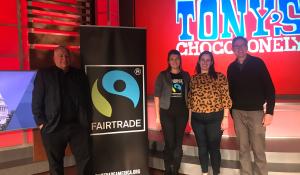
Heal Your Home Center: Healthy Home Glossary
Ever wonder exactly what Volatile Organic Compounds (VOC's) and endocrine disrupters are? Green America's Healthy Home Glossary comes in handy for those who want to learn more about the pollutants so often mentioned on our website, especially within the Healthy Home Tool Kit. Getting familiar with these common culprits can help ensure your bedroom, bathroom, kitchen, and overall home is healthy and free of toxins.
1,4-Dioxane: (a.k.a. iethylene dioxide, diethylene ether, dioxan, p-dioxane, or just “dioxane”) Used as a coolant in cars and as a foaming agent in some body care products, including baby shampoo. A recognized carcinogen and a suspected blood, gastrointestinal, immune, kidney, nerve, respiratory, and skin toxicant.
Aluminum: A lightweight metal used in cooking utensils and beverage containers. A suspected blood, nerve, reproductive, and respiratory toxicant. Suggestions that ingested aluminum may have some link to Alzheimer’s disease are inconclusive.
Arsenic: A recognized carcinogen and developmental toxicant. Suspected of being toxic to the human blood, endocrine, gastrointestinal, immune, nerve, reproductive, respiratory, and skin systems.
Arsenic disulfide: Used as a pesticide on produce. A recognized carcinogen and developmental toxicant.
Benzyl benzoate: A common insecticide for lice and mites, as well as a food additive, a fragrance fixative, and plasticizer. A suspected neurotoxin.
Bisphenol-A: Used to make transparent, hard plastic known as polycarbonate (#7), such as baby bottles and the lining of infant formula cans. Exposure may cause prostate cancer, breast cancer, female infertility, endocrine disruption, and obesity.
Chromium copper arsenate (CCA): A compound that was once used on pressure-treated wood. Leaches arsenic.
Crystalline silica: (a.k.a. “silica gel”) Usually found in a small packet serving as a desiccant. Packaged with items that might mold or spoil when wet, and a component in play sand. A known carcinogen and a suspected toxin to the gastrointestinal, kidney, and respiratory systems. Fine silica can hurt the respiratory tract if inhaled, but presents a low threat in skin care products and in food.
DEHP: (aka Bis(2-ethylhexyl)phthalate, BEHP, di-2-ethyl hexyl phthalate, dioctyl phthalate, or DOP) A liquid plasticizer used in hydraulic fluids and PVC (#3) plastic. While DEHP cannot cause harm through skin contact, when ingested it can damage reproductive organs, the lungs, kidneys, and liver, and fetuses.
Dichlorobenzene: Used in mothballs, urinal “cakes,” and other disinfectants designed to control moss and mildew. A suspected carcinogen.
Diethanolamine (DEA): (a.k.a. bis(hydroxyethyl)amine, diethylolamine, hydroxydiethylamine, diolamine, and 2,2’-iminodiethanol) Colorless crystals used in cosmetics, where it is suspected of combining with another common chemical to produce highly carcinogenic nitrosamines. Alone, it’s a suspected carcinogen and a suspected toxicant to the blood, gastrointestinal, kidney, nerve, respiratory, and skin systems. Damages fetal development in mice.
Dioxin: (a.k.a. Dioxine, TCDBD, TCDD, 2,3,7, 8-TCDD) A byproduct of chlorine manufacture and PVC incineration. A recognized carcinogen and developmental toxicant, and suspected of being toxic to blood, endocrine, gastrointestinal, immune, kidney, nerve, reproductive, respiratory, and skin systems.
Endocrine disrupters: The endocrine system regulates hormones and the glands that secrete those hormones in the body. Endocrine disrupters (a.k.a. endocrine disrupting compounds, endocrine modifiers, or hormone disrupters) are chemicals that interfere with the endocrine system by mimicking or inhibiting natural hormones. They can cause reproductive damage and have been implicated in cancers of the reproductive system.
Formaldehyde: (a.k.a. methanal, methyl aldehyde, or methylene oxide) A smelly colorless gas found in pesticides as well as in consumer products and building materials. A recognized carcinogen and suspected gastrointestinal, immune, nerve, reproductive, respiratory, and skin toxicant.
Hormone Disrupters: See endocrine disrupters.
Lead: A heavy, soft grey metal once used widely in paints. It is now illegal as a paint ingredient over 660 ppm, though it may legally be mixed into other products, like jewelry. Some imported toys containing lead have recently raised alarms about children’s exposure. A recognized carcinogen and neurological, developmental, and reproductive toxicant. Also suspected of being toxic to people’s blood, endocrine, gastrointestinal, immune, kidney, respiratory, and skin systems.
Mercury: A heavy metal recognized as a developmental toxicant and suspected of being toxic to humans’ blood, endocrine, gastrointestinal, immune, kidney, nerve, reproductive, respiratory, and skin systems. People are most likely to be exposed to mercury by eating contaminated fish and by drinking contaminated water.
Naphthalene: (a.k.a. naphthalin, tar camphor, or white tar) Used in many dyes and as a fumigant in household products such as mothballs, where it gives them their signature smell. A recognized carcinogen and a suspected toxicant to the blood, developmental, gastrointestinal, nerve, respiratory, and skin systems.
Parabens: Parabens are widely used as preservatives in pharmaceuticals and cosmetics, and are found in toothpaste, shampoo, moisturizers, and shaving gels. Suspected of toxicity to skin. Some studies have linked parabens to cancer and to endocrine disruption.
Perfluorochemicals (PFCs): PFCs are widely used in well-known consumer brands including Teflon, Stainmaster, Scotchgard, and Gore-Tex (they have subsequently been phased out of Scotchgard). Laboratory studies on animals have linked them to several cancers, thyroid problems, damage to the immune system, reproductive problems, and birth defects.
Perfluorooctanoic Acid (PFOA): (a.k.a. C8) Used in the manufacture of nonstick cookware such as Teflon, Gore-Tex fabric, and StainMaster carpet. PFCs in microwave popcorn bags may form PFOA when ingested. A persistent, bioaccumulative chemical that may be linked to cancer, heart disease, and immune system damage.
Phenol: (a.k.a. carbolic acid, hydroxybenzene, monohydroxybenzene, phenyl alcohol, or phenyl hydroxide) A crystalline solid widely used in antiseptic sprays and cleaners, paint removers, and disinfectants. Suspected of being toxic to people’s blood, developmental, gastrointestinal, kidney, nerve, reproductive, skin, and respiratory systems.
Phthalates: Commonly used as softeners in polyvinyl chloride (PVC), other soft plastics, and in a variety of beauty and skin care products. Studies have identified phthalates as endocrine disrupters. Phthalates may also cause liver and kidney lesions, lead to a higher risk of certain cancers, and may exacerbate asthma and allergies in children.
Polybrominated diphenyl ethers (PBDEs): PBDEs were commonly used as fire retardants in foam furniture until 2005, when the most commonly used form was banned. PBDEs are neurotoxins that bioaccumulate, building up in people’s bodies over time. New carpet padding may likely still contain PBDEs, and PBDEs have been found in many fish.
Polycarbonate (#7) plastic: A transparent, hard, unbreakable plastic that offgasses bisphenol-A, a suspected endocrine disrupter.
Polychlorinated biphenyls (PCBs): Cancer-causing, persistent chemicals that were once used widely as coolants, fire retardants, and additives in paints and pesticides. PCBs were banned in the United States in 1976, but they persist in the environment, contaminating a number of animals, particularly farmed salmon. Salmon with PCBs can be a carcinogen to those who eat them, and a neurotoxin to fetuses when pregnant women eat salmon.
Polystyrene (#6) plastic: The white “foam” commonly used for packing peanuts, protective packaging, and “clamshell” take-out containers. May leach some benzene, a known carcinogen, into the food when heated. Difficult to recycle and very slow to biodegrade.
Polytetrafluoroethylene (PTFE): This is the resin coating associated with Teflon brand and other non-stick cookware. It breaks down at high temperatures into chemicals linked to neurotoxicity, respiratory damage, and human polymer fume fever. May be harmful to pets.
Polyvinyl chloride (PVC): (a.k.a. vinyl or #3 plastic) Generates carcinogenic dioxin when manufactured and incinerated. In its pliable plastic form, it can leach phthalates, which are endocrine disrupters.
Quaternary ammonium compounds: (a.k.a. quaternary ammonium cations or quats) are used widely in disinfectants, fabric softeners, and pesticides. A respiratory irritant.
Sodium Lauryl Sulfate (SLS): (a.k.a. sodium dodecyl sulfate, sulphate, SDS, or NaDS) Used as a foaming agent in toothpaste, shampoo, shaving creams, and bubble baths, and as a tick repellant in pet products. A suspected gastrointestinal and liver toxicant.
Volatile Organic Compounds (VOCs): Any one of a category of chemicals that are chemically volatile—that is, they evaporate into the air and react to sunlight, forming ground-level ozone and damaging indoor air quality. (“Organic” here is a scientific term indicating that the chemical contains carbon.) VOCs pose a particular risk of developmental damage to infants and fetuses. Some commonly used VOCs include formaldehyde and other endocrine disrupters.
—Sources for this glossary include Environmental Defense’s Scorecard.org database and the Environmental Working Group’s scientific research.







